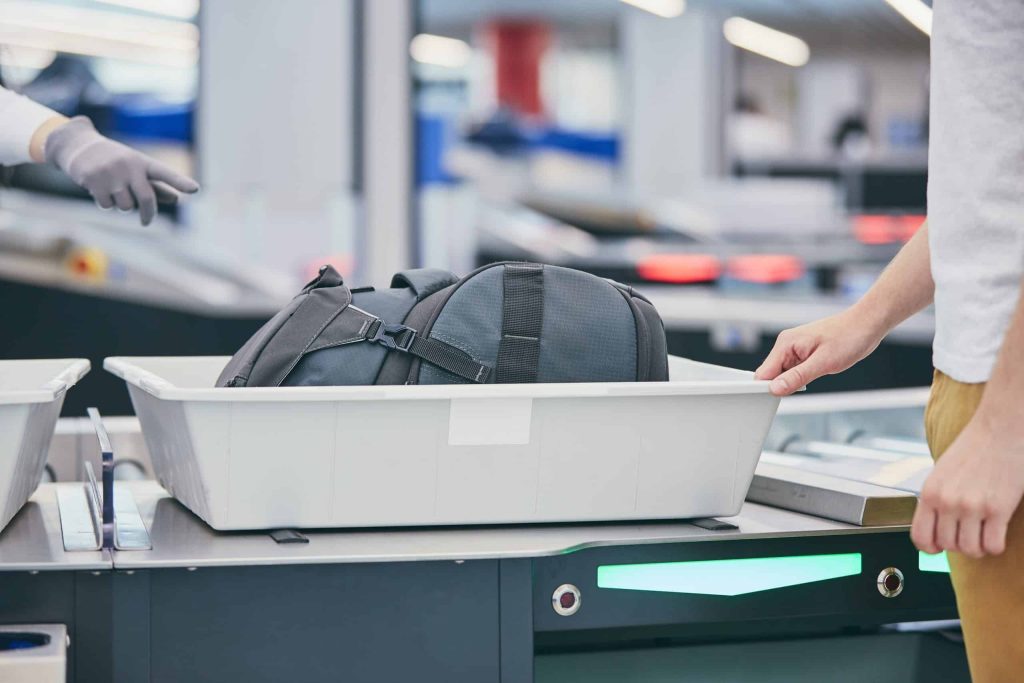Waiting in line for TSA screenings at the airport can be stressful if you are not prepared.
In your mind, you’re probably going over a mental checklist to make sure you’ve got everything packed and that you didn’t forget anything at home. The last thing you want to do is hold up the line for your fellow travelers or get pulled out of line because you forgot to take your keys out of your pocket and you set off an alarm.
You can reduce your stress and make your TSA screening experience quick by planning ahead and packing your luggage to fit the latest TSA guidelines.
Let’s discuss those and some helpful tips to keep in mind the next time you travel.
YOUR BOARDING PASS AND ID
First, remember to have a government-issued identification card, such as a driver’s license or passport, with you at all times, and keep it in an easy-to-reach place.
TSA installed Credential Authentication Technology (CAT) scanners at South Bend International Airport. As you enter the security checkpoint an agent will scan your photo identification confirming your flight information in near real-time. You will no longer present your boarding pass to TSA officials.
You must ensure that you have checked-in and downloaded your boarding pass to your phone through the airline’s mobile app or printed a boarding pass at the ticket counter before going through security. You will show your boarding pass to the airline gate agent before getting on your flight. Boarding passes cannot be printed at the gate.
CARRY-ON BAGS
At South Bend International Airport, TSA installed new 3D scanners that allow all passengers to keep their laptops and 3-1-1 liquids in their bags.
The state-of-the-art computed tomography (CT) X-ray scanners generate a 3-D X-ray image on-screen that TSA agents can view and rotate for a better analysis of the bag’s contents, which means fewer bag checks will be required. This is the same technology used in the medical field for CT scans.
While you won’t need to remove your laptops or cell phones, note that all bags must be placed in a bin for screening, including carry-on suitcases, rather than directly on the belt.
You’re allowed to keep most food items in your bag, but liquids, gels, creams, pastes and aerosols are a different story. These items must be in small, travel-sized containers of 3.4 oz (100 milliliters) or smaller each. All of these items have to fit inside a resealable quart-sized bag. If you have larger containers or too many items to fit inside the quart-sized bag when it’s sealed, you must pack them in checked luggage.
There are exceptions to that rule for medications and medically necessary items such as baby food, breast milk and formula. These items should be stored separately from your other liquids and should also be easily accessible. Alert the TSA officer that you have these items and expect to go through alternate screening measures.
At other airports that don’t yet have CT scanning technology, you’ll be asked to remove any personal electronic devices such as cell phones, laptops, tablets and personal gaming consoles, from your carry-on bag and place them on the X-ray belt in their own totes with nothing underneath or on top of them. You’ll also be asked to remove your quart-sized bag containing your 3-1-1 liquids and place that in a bin for scanning. Make sure that these items are easily accessible so that you can quickly remove them from your bag when you reach TSA, and then re-pack them once you’ve passed through security.
CHECKED LUGGAGE
While you can pack large containers of liquids in your checked luggage, the TSA does restrict and prohibit other items.
For example, if you are flying to a destination to go camping, you can pack a camp stove in your checked luggage if it is empty of all fuel and cleaned so that no fuel vapors or residue are on the stove. Butane or other fuel that you may need for the stove is not allowed in checked or carry-on luggage, and should instead be purchased once you reach your destination.
Screeners do not open all checked luggage for inspection but they have discretion to do so. If they do open your luggage, they will leave a notice of baggage inspection inside. TSA inspectors may need to break open locked luggage. You can purchase luggage locks from Safe Skies Luggage Locks and Travel Sentry that the TSA can open without breaking.
SIMPLIFY YOUR TRAVEL ATTIRE
To save time, keep your items normally stored in your pockets — such as sunglasses, wallets, and keys — in your carry-on bag. Avoid wearing a belt if possible, as all belts need to be removed and placed in a bin during screening.
If you can, wear slip-on shoes through screening, so you can take them off and put them back on faster. You can keep your shoes on while you’re waiting in line, but you should consider having your shoes unlaced and taking them off when you’re close to reaching the TSA conveyor belt.
CONSIDER TSA PRE-CHECK®
You can save significant time during pre-flight screening by enrolling in TSA PreCheck®. Benefits include leaving on shoes and light jackets, and leaving 3-1-1 liquids and laptops in carry-on bags at all airports, regardless of the checkpoint technology. For those who travel often, the $78 price tag for five years is worth the investment. In addition, in January 2023, 92% of TSA PreCheck® passengers waited less than 5 min at all airports. The process of applying for TSA PreCheck® and getting approved can take up to 90 days, so travelers should plan ahead before upcoming travel.
If you value a quick and easy travel experience, you’ll love flying from South Bend International Airport. We offer nonstop flights to twelve destinations with connections worldwide. To book your next trip with us, check out the airlines who fly with us.

